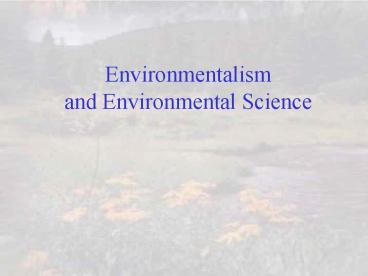Environmentalism - PowerPoint PPT Presentation
1 / 15
Title:
Environmentalism
Description:
The media generally presents issues in an 'either/or' fashion. ... Scientist 5: http://www.telegram.com/extra/crosscurrents/photos/ecologist.jpg ... – PowerPoint PPT presentation
Number of Views:1107
Avg rating:3.0/5.0
Title: Environmentalism
1
Environmentalism and Environmental Science
2
You are signed up for an environmental science
course...
so what is it?
First, lets make sure we understand some terms.
3
What is the difference between an
environmentalist and an environmental scientist?
Environmentalists usually advocate strong
conservation or preservation of the environment
They are deeply committed to causes that protect
environmentally sensitive areas, reduce demand
on the environment, and advocate laws or actions
to support this.
4
Other definitions?
Conservationist- someone who works to protect
the environment from destruction or pollution
(synonym- environmentalist)
Preservationist- someone who keeps safe from
harm or danger
Radical environmentalism or environmental
terrorism- using whatever means necessary to
stop environmental use and/or destruction
Usually, though, preservationists believe in not
using the environment (preserving it) while
conservationists believe in very limited
environmental use
5
Arent we all environmentalists?
Environmentalism is, though, a little hard to
define. In a recent survey, when people were
asked if they were environmentalists, about ¾
said yes.
Environmentalism does mean different things to
different people.
6
Environmental science looks at cause and effect
relationships in nature.
Environmental scientists attempt to understand
the complex interactions among such components as
organisms and physical factors and use this
information to make management and planning
decisions about environmental issues (such as
urban planning, resource use, agricultural
management, pollution control, and many others).
7
Environmental science applying principles of
science to these problems
8
What do environmental scientists study?
The easy answer is that they study the
environment, but in reality it is more complex
than thatchemists, geologists, meteorologists,
biologists, geographers, demographers,
hydrologists, mathematicians, statisticians,
economists, computer experts, foresters, urban
planners etc. all contribute aspects to
environmental knowledge and understanding
9
How do environmental scientists study the
environment?
- Direct observation
- Hypothesis testing
- Data collection
- Historical data
- Simulation and computer modeling
However, environmental investigations are often
complicated by scale, other interactions, lack of
replication, and other factors. Some
traditional science (observations, controlled
experiments) is a little more difficult.
10
Environmental science is complicated by the
publics misunderstanding of some environmental
issues. The media misinforms the public by
promoting simplistic solutions like paper not
plastic and Dont use Styrofoam, it is bad for
the environment. The media generally presents
issues in an either/or fashion.
Did you know that it is actually less harmful to
the environment to produce Styrofoam instead of
paper? Disposal is still a problem for Styrofoam
but more recycling is being done. Paperboard is
for the most part coated in wax or plastic,
making it neither biodegradable nor recyclable.
11
This environmental awareness is relatively
new It wasnt until the 1960s that the
environment was significantly addressed now it
widely accepted as a major political and social
issue
Modern day challenge has become the issue of
environmental use/abuse
12
Can we continue to use such resources as forests,
fish, wildlife, energy in the ways we have in the
past? Is it sustainable?
13
Sustainability.one definition
Sustainability is about living and working in
ways that meet and balance existing
environmental, economic and social needs without
compromising the well-being of future
generations. (http//www.sustreport.org/)
But how do we balance human economic issues and
environmental issues?
14
What is a tree worth?
15
Background Image from http//sungraph.tripod.com/n
ature.html Environmentalists picture
http//www.fresnobee.com/man/projects/yearendphoto
s/valley/photo16.html Scientist image
http//www.literacynet.org/polar/pop/html/team-coc
hran.html Scientist in field http//www.outthere.
co.za/july97/disp4jul/Scientist.JPG Scientist 3
http//www.churchilltrust.org.au/images/scientist.
jpg Scientist 4 http//www.uop.ucar.edu/uop_graph
ics/vsp.jpg Scientist 5 http//www.telegram.com/e
xtra/crosscurrents/photos/ecologist.jpg Scientists
6 http//www.werc.usgs.gov/lasvegas/todd2.jpg Fi
re picture http//ecoconnections.catawba.edu/defo
rest.htm Styrofoam http//www.links.net/vita/t
rip/japan/food/tsukiji/pix/030-styrofoam.lg.jpg Me
dia imagehttp//www.nrel.gov/media/images/intervi
ew_photo.gif Calendar http//www.finaid.umich.edu
/employ/images/Calendar.jpg Birds
http//www.interknowledge.com/aruba/wildlife.jpg
Wildlife (bear) http//www.dced.state.ak.us/tour
ism/images/wildlife.jpg Alligator
http//www-pao.ksc.nasa.gov/kscpao/visit/photos/93
pc780.jpg Fish catch http//www.photolib.noaa.go
v/fish/images/fish0702.jpg Balance
http//www.ma-strasbourg.justice.fr/images/balance
.gif Energy flow (color) http//gened.emc.maricop
a.edu/bio/bio181/BIOBK/enflow.gif Tree
http//www.ibiblio.org/wm/paint/auth/friedrich/fri
edrich.solitary-tree.jpg Pollution
http//jin.jcic.or.jp/access/pollution/media/pollu
tion._top.jpg Alaska oil spill
http//www.atofinachemicals.com/oilspill/images/al
aska1.jpg Globe http//www.cnnradionet.com/PUBLI
C/Home/noticias/graphics/Globe.jpg Carrying
capacity http//emuseum.mnsu.edu/biology/evolutio
n/images/mathusianpopulation.gif Energy flow
http//www.on.ec.gc.ca/great-lakes-atlas/images/bi
g05.gif Ecosystem http//www.epa.gov/asmdnerl/mo
dels3/doc/images/ecosystem.jpg Ecosystem II
http//www.netusa1.net/gwmager/Images/ecosystem.j
pg Biogeochemical cycle http//www.jamstec.go.jp/
jamstec-e/kansoku/image/gazou/big_jyunkan.jpg
Carbon cycle http//envstudies.brown.edu/thesis/
2001/rowland/Images/carbon20cycle.jpg Baby
image http//www.littleforest.com/babies.gif
Chief Seattle http//www.magna.com.au/prfbrown/
thechief.html Nature scene http//eddie.cis.uogu
elph.ca/tburgess/pics/scene1.jpg Food web
http//www.estuarylive.org/reference/Food20Web.jp
g Food web drawing http//www.cyberenet.net/aed
mills/biorefweb/foodweb.gif
Credits































